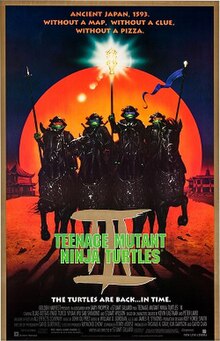Teenage Mutant Ninja Turtles, commonly abbreviated as TMNT, is a media franchise created by the comic book artists Kevin Eastman and Peter Laird. It follows Leonardo, Donatello, Raphael and Michelangelo, four anthropomorphic turtle brothers trained in ninjutsu who fight evil in New York City. Supporting characters include the turtles' sensei, a rat called Splinter, their human friends April O'Neil and Casey Jones, and enemies such as Baxter Stockman, Krang, and their archenemy, the Shredder.

Donatello, nicknamed Don or Donnie/Donny, is a superhero and one of the four main characters of the Teenage Mutant Ninja Turtles comics and all related media. He is the smartest and often gentlest of his brothers, wearing a purple mask over his eyes. He wields a bō staff, his primary signature weapon in all media.
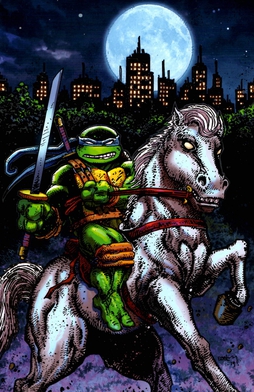
Leonardo, commonly nicknamed Leo, is a superhero appearing in Teenage Mutant Ninja Turtles comics and related media, and created by American comic book artists Kevin Eastman and Peter Laird. He is one of the four central characters of the franchise, along with his brothers, Donatello, Raphael, and Michelangelo. Leonardo is the leader and strategist of the turtles.

Raphael, nicknamed Raph, is a superhero and one of the four main characters of the Teenage Mutant Ninja Turtles comics and all related media. In most iterations, he is depicted as the most aggressive of the turtle brothers, physically the strongest, and often at odds with his brother, Leonardo.

Michelangelo, nicknamed Mike or Mikey, is a superhero and one of the four main characters of the Teenage Mutant Ninja Turtles comics and all related media. Michelangelo is characterized as the most naturally gifted of the four brothers but prefers to have more leisure rather than train. The most jocular and energetic of the team, he is shown to be rather immature; he is known for his wisecracks, quick-wit, optimism, and love of skateboarding and pizza. He is usually depicted wearing an orange eye mask. His signature weapons are a single or dual nunchaku, though he has also been portrayed using other weapons, such as a grappling hook, manriki-gusari, kusarigama, tonfa, and a three-section staff. He is commonly portrayed in media as speaking with a California accent and is most associated with the "Cowabunga" expression that became a pop culture phenomenon.

The Shredder is a supervillain and the main antagonist of the Teenage Mutant Ninja Turtles media franchise created by Kevin Eastman and Peter Laird. The character debuted in the Mirage Studios comic book Teenage Mutant Ninja Turtles #1, and has since endured as the archenemy of the turtles and their Master Splinter.

Splinter, often referred to as Master Splinter or Sensei by his students/sons, is a fictional character from Teenage Mutant Ninja Turtles comics and all related media. A mutant rat, he is the grave and stoic sage of the Turtles, their ninjutsu and martial arts instructor, and their adoptive father. The character was originally a parody of the Marvel Comics character Stick.

Teenage Mutant Ninja Turtles II: The Secret of the Ooze is a 1991 American superhero action comedy film based on the Teenage Mutant Ninja Turtles characters created by Kevin Eastman and Peter Laird. Directed by Michael Pressman and written by Todd W. Langen, it is the second installment in the original Turtles film trilogy and the sequel to Teenage Mutant Ninja Turtles (1990). It stars Paige Turco and David Warner, with the voices of Brian Tochi, Robbie Rist, Adam Carl, and Laurie Faso. Resuming from the events of the first film, the Shredder returns at command of the Foot Clan for revenge on the Turtles. When he learns the secret behind the Turtles' mutation, he becomes more dangerous than ever. The film reveals the origins of Splinter and the Turtles and introduces two new villains, Tokka and Rahzar. Unlike the first film, the Turtles mostly fight bare-fisted, to tone down the violence.
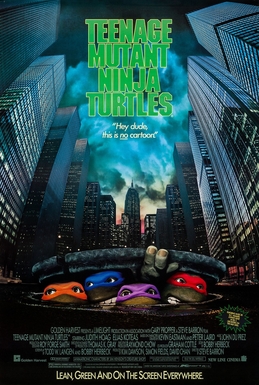
Teenage Mutant Ninja Turtles is a 1990 American superhero action comedy film based on the comic book characters created by Kevin Eastman and Peter Laird. It is the first film adaptation of the characters and was directed by Steve Barron and written by Todd W. Langen and Bobby Herbeck from a story by Herbeck. It stars Judith Hoag and Elias Koteas with the voices of Brian Tochi, Josh Pais, Corey Feldman, and Robbie Rist. Teenage Mutant Ninja Turtles follows the Turtles on a quest to save their master, Splinter, with their new allies, April O'Neil and Casey Jones, from the Shredder and his Foot Clan.

TMNT is a 2007 animated superhero film written and directed by Kevin Munroe in his feature directorial debut. It is the fourth theatrical Teenage Mutant Ninja Turtles film. The first animated film in the franchise, it features an ensemble voice cast including Chris Evans, Sarah Michelle Gellar, Mako, Kevin Smith, Patrick Stewart, and Ziyi Zhang with narration by Laurence Fishburne. In the film, after having grown apart following the final defeat of their arch-enemy, the Shredder, the four Turtles — Leonardo, Raphael, Donatello, and Michelangelo — are set to reunite and overcome their faults to save the world from evil ancient creatures.

Teenage Mutant Ninja Turtles (TMNT) is a comic book series that was published by Mirage Studios between 1984 and 2014. Conceived by Kevin Eastman and Peter Laird, it was initially intended as a one-shot, but due to its popularity it became an ongoing series. The comic created the Turtles franchise of five television series, seven feature films, numerous video games, and a range of toys and merchandise.

Action figures based on the Teenage Mutant Ninja Turtles franchise have been produced by Playmates Toys since 1988. Staff artists at the Northampton, Massachusetts based Mirage Studios have provided conceptual designs for many of the figures, vehicles, and playsets and are credited on the packaging of the products they created.

Teenage Mutant Ninja Turtles is a beat 'em up video game developed and published in 2003 by Konami, based on the 2003 TV series.
The Teenage Mutant Ninja Turtles, a superhero team created by Kevin Eastman and Peter Laird, have appeared in seven theatrical feature-length films since their debut. The first film was released in 1990, at the height of the franchise's popularity. Despite mixed reviews from critics, it was a commercial success that garnered two direct sequels, Teenage Mutant Ninja Turtles II: The Secret of the Ooze in 1991 and Teenage Mutant Ninja Turtles III in 1993, both of which were modest successes.
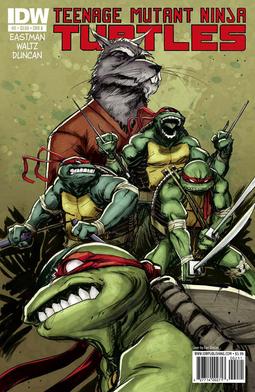
Teenage Mutant Ninja Turtles is an ongoing American comic book series published by IDW Publishing. Debuting in August 2011, the series is part of the Teenage Mutant Ninja Turtles media franchise created by Kevin Eastman and Peter Laird and was the first new comic incarnation of the Turtles to debut after the franchise's sale to Nickelodeon in October 2009. It is the fifth comic book series in the franchise's publication history and serves as a reboot of the franchise's story and characters.
Teenage Mutant Ninja Turtles is an American animated television series developed by Ciro Nieli, Joshua Sternin, and Jennifer Ventimilia for Nickelodeon, based on the characters created by Kevin Eastman and Peter Laird. The series begins with the Turtles emerging from their sewer home for the first time, using their ninjutsu training to fight enemies in present-day New York City. The series ran in the United States from September 28, 2012, to November 12, 2017.
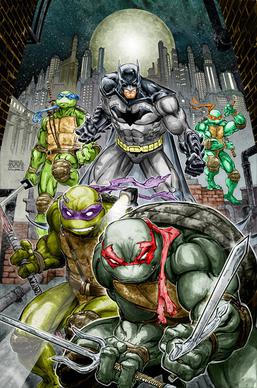
Batman/Teenage Mutant Ninja Turtles is a six-issue intercompany crossover comic book miniseries featuring fictional heroes Batman and the IDW incarnation of the Teenage Mutant Ninja Turtles. The series was written by James Tynion IV and illustrated by Freddie Williams II.
Lego Teenage Mutant Ninja Turtles was a Lego theme based on the Teenage Mutant Ninja Turtles entertainment franchise first created by Kevin Eastman and Peter Laird. The theme was first introduced in 2012 and was discontinued by the end of 2014. Also included sets based on both the 2012 animated series from Nickelodeon and the 2014 film produced by Michael Bay.

Rise of the Teenage Mutant Ninja Turtles: The Movie is a 2022 American animated superhero film that is a continuation of the animated television series Rise of the Teenage Mutant Ninja Turtles (2018–20). The film was directed by series co-developers Andy Suriano and Ant Ward from a screenplay by Tony Gama-Lobo and Rebecca May, based on a story by Suriano and Ward. It stars the show's regular voice cast of Ben Schwartz, Omar Miller, Brandon Mychal Smith, Josh Brener, Kat Graham, and Eric Bauza, with newcomer Haley Joel Osment as Casey Jones. In the film, the Turtles, with the help of their new ally from the future, Casey Jones, set out to stop the evil alien force, the Krang, from invading Earth.
